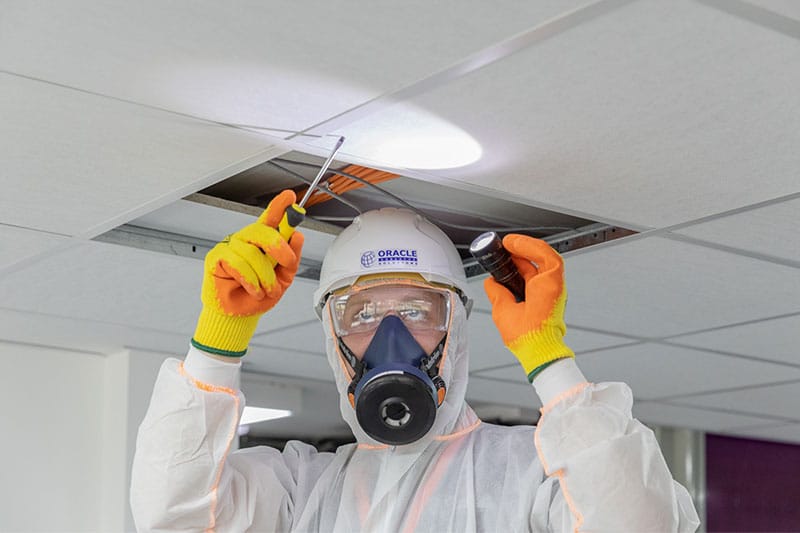Asbestos Surveying – What should loss adjusters and insurers look out for?
Asbestos surveying plays a crucial role in insurance claims assessment, in situations where asbestos-containing materials (ACMs) may have been damaged or disturbed as a consequence of an “insured event” such as fire, storm, or flood.
After all, the “perils” that are covered by an insurance policy on a building can bring hugely wide-ranging and not-always-predictable results if they do occur. In some cases, only minor damage might be caused to a given property, with little or no implication for any ACMs contained inside. On other occasions, however, the damage to a building and any contained ACMs might be catastrophic, bringing serious legal and safety consequences.
As we have written about in the past here at Oracle Solutions, it isn’t explicitly stated in UK law that an asbestos survey needs to be carried out on a building where ACMs might be present.
However, the UK’s overarching asbestos legislation – the Control of Asbestos Regulations 2012 (CAR 2012) – does set out a “duty to manage” asbestos in non-domestic premises. A key element of this for a dutyholder – in other words, the owner of the given building, or an individual or organisation with clear responsibility for maintaining or repairing the property – is taking reasonable steps to determine whether ACMs are present.
In practice, it is frequently extremely difficult to uncover such information, unless an asbestos survey is carried out on the property. So, an asbestos survey might effectively be a mandatory requirement for a particular premises under CAR 2012.
Presuming an asbestos survey is required for a specific building, in the event of an insurance claim being made for damage, a representative of the insurer who makes an in-person visit to inspect the building should request and inspect this survey. This should be done either prior to entering the premises, or as soon as possible during the visit.
What types of asbestos surveys are there?
There are two broad types of asbestos survey: management surveys, and refurbishment or demolition surveys.
- An asbestos management survey is meant to assist the dutyholder with the management of ACMs during the given premises’ normal occupation and use. It is largely geared towards helping the dutyholder to put together an asbestos register and an asbestos management plan. It is this type of asbestos survey that a visiting insurer representative will often request prior to inspecting a building.
- An asbestos refurbishment or demolition survey is typically arranged by a dutyholder prior to planned major refurbishment or demolition of a building in which ACMs are confirmed or suspected to be present. This type of survey involves destructive inspection and potential asbestos disturbance. A refurbishment or demolition survey is not normally required for insurance repair or reinstatement.
What are the key indicators of asbestos presence in a property?
So heavily was asbestos used during its peak period of adoption in the UK from around the 1950s until the 1980s, there are known to have been thousands of products that contained the naturally occurring, but lethal mineral.
Such qualities of asbestos as its physical strength, fire resistance, and effectiveness as an insulator led to it being incorporated into asbestos insulating board (AIB), asbestos cement roofing, asbestos vinyl floor tiles, textured decorative coatings, thermal insulation (lagging), and many other products.
It is therefore difficult to sum up exactly what asbestos looks like in a property. In any case, no one should ever depend on sight alone as a means of confirming whether a specific material or product does or does not contain asbestos.
Nonetheless, our guide to what asbestos looks like might be helpful in determining which products at a given premises may be especially likely to contain the now-banned substance.
In most of its commercial forms, asbestos tends to have a fuzzy and fluffy texture, perhaps resembling candy floss or insulation. When asbestos walls or floor tiles are broken, strands of asbestos fibres may be visible. None of these visual signifiers, however, should be taken as definitive confirmation of a particular material being asbestos.
How should asbestos surveys be conducted during claims processing?
As referenced above, the exact steps involved in an asbestos survey will largely depend on the type of asbestos survey involved.
An asbestos management survey, for instance, is not typically intrusive, so does not involve any damage to the fabric of the building other than what is strictly necessary for taking samples. There is not typically any intrusive or destructive penetration of the property’s deeper structure.
By contrast, if a refurbishment or demolition survey is sought, this will be intrusive in nature. The extent of such intrusive inspection with a refurbishment survey will be largely dictated by what form the planned refurbishment is set to take. However, the surveying will typically be localised around the area where the refurbishment will be undertaken.
Finally, a demolition survey is a full-scale intrusive survey. This will be necessary because when demolition of part or the entirety of a property takes place, large-scale disturbance of any ACMs contained inside will almost certainly occur. So, dutyholders, insurers, and loss adjusters alike will need to be alert to such potential risks. As part of this, they must ensure a suitably thorough survey has been undertaken to identify asbestos deep in the building structure.
What qualifications should a professional asbestos surveyor have?
If there is a need to appoint someone to carry out an asbestos survey of a given property, it will be essential that this individual is competent to do the job. Only a surveyor who has deep expertise in this area should be hired, so that dutyholders, insurers, and loss adjusters can have the utmost confidence in the safety, legal compliance, and quality of the surveyor’s work.
We have previously written in depth about the skills and qualifications that a professional asbestos surveyor should have. Many people who eventually become asbestos surveyors begin their training journey with a university degree in a field such as civil engineering or construction management, before enrolling in specialist asbestos surveyor training.
If the professional that carries out an asbestos survey holds either the Royal Society for Public Health (RSPH) Level 3 Award in Asbestos Surveying or the British Occupational Hygiene Society’s (BOHS) P402 qualification, this will be a good indication of their capabilities.
What are the risks associated with incomplete or inaccurate asbestos surveys?
It is in the interests of dutyholders, insurers, and loss adjusters alike to ensure that in every case, a thorough asbestos survey has been carried out by a reputable professional. The steps we have outlined in this article, including ensuring the right type of asbestos survey for the given situation is carried out, will help ensure the most accurate and complete survey.
This accuracy and completeness, in turn, will help make sure informed measures are taken to manage and potentially remove the affected ACMs. It will help to prevent or minimise any health risks arising from the ACMs, as well as any legal liabilities that might arise if any breaches of asbestos legislation were to occur (bearing in mind that violations of asbestos law can bring hefty fines and even imprisonment).
Finally, of course, the damaged property having been subject to a comprehensive and accurate asbestos survey will help ensure any claim made on the insurance is based on true information about the ACMs on the premises.
What documentation should be produced from an asbestos survey?
Once an asbestos survey has been carried out on a given site, a comprehensive report will be put together. This document will provide in-depth information about all the asbestos materials the surveyor found to be present in the building. It will also include photographs and recommendations on the steps to take to safely manage the on-site ACMs.
We have previously written about the various details that can be found in an asbestos survey report. The information that will be included will encompass, but will not be limited to:
- General information about the survey and site
- The name and address of the surveyed premises
- The date of the report, and the date of the survey
- A description of the areas the survey includes
- The survey method used
- Plans
- The bulk analysis report/table
How should findings from asbestos surveys influence the claims process?
The information that is provided in the asbestos survey for the damaged property will be crucial for insurers and loss adjusters as they seek to process the policyholder’s claim and make decisions following in-person inspection of the site.
As we referenced above, the asbestos survey – which, in the case of a given commercial property, is likely to be required by law – should be requested and reviewed by the representative of the insurer prior to that individual entering the property to inspect it, or as early as possible during the visit.
The loss adjuster or contractor who conducts this in-person visit will need to have received training that enables them to identify potential ACMs. They must also be able to identify where such materials have been damaged, and identify where the materials may be disturbed when repair work takes place.
Where suspected ACMs have been identified, validation should include the costs of any required asbestos tests. In the event of work being needed to encapsulate or remove and dispose of ACMs in relation to insured damage, the reasonable cost of such work should be accounted for in the validation process – including the expense involved in hiring licensed contractors, where this is necessary.
Having carried out the inspection, the loss adjuster will be able to instruct contractors or suppliers. The results of an asbestos survey, then, play a major role when tightly integrated into the claims assessment and decision-making process.
Conclusion: asbestos surveys help ensure accuracy, compliance, and safety
It is of the greatest importance that asbestos surveying is carried out to the highest standards of completeness and thoroughness for any property subject to this legal requirement under CAR 2012. Indeed, this legal requirement means an asbestos survey should already have been carried out on a given non-domestic premises long before any “insured event” leads to the policyholder making a claim and an insurer representative conducting an in-person inspection.
Insurers and loss adjusters can play their own role in ensuring that asbestos is dealt with in a legally compliant, safe, and accurate way at the damaged property. For example, the insurer will need to ensure they only appoint a representative or contractor who is genuinely competent to undertake the work they will be expected to undertake, having received the appropriate level of asbestos training.
To find out more about any of our own wide-ranging asbestos services here at Oracle Solutions, and to ask for a free and fast quote, please don’t hesitate to contact us via phone or email today.

Written by Callum McDonald
Callum McDonald is an expert in asbestos quality management, ensuring rigorous adherence to regulations and high-quality standards in removal projects. His focus on enhancing quality and client satisfaction makes him a crucial asset in safety and compliance within the field. Callum's expertise in technical support and oversight of licensed works underscores his commitment to excellence in asbestos management, providing invaluable guidance to clients in this specialised area.

